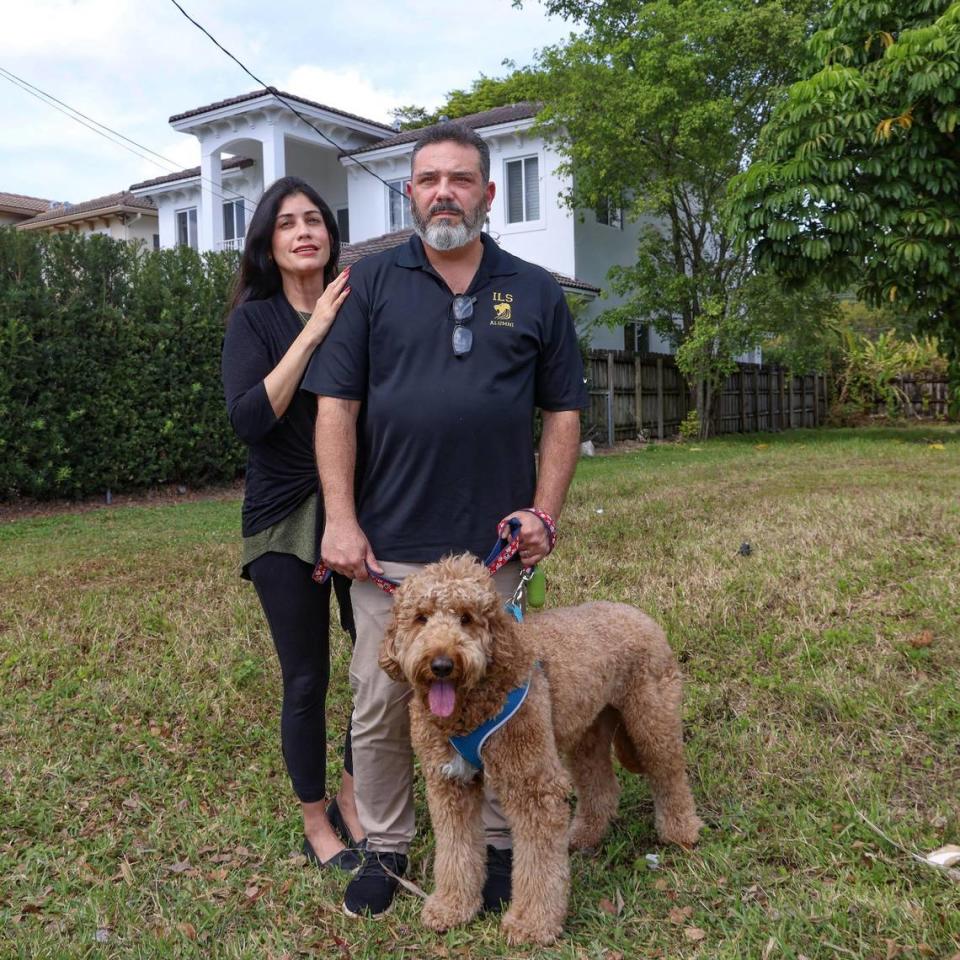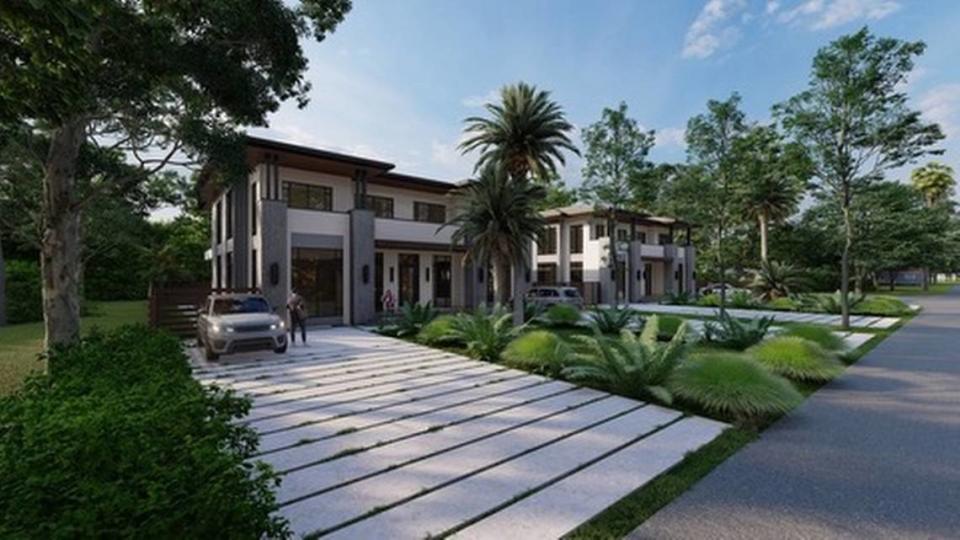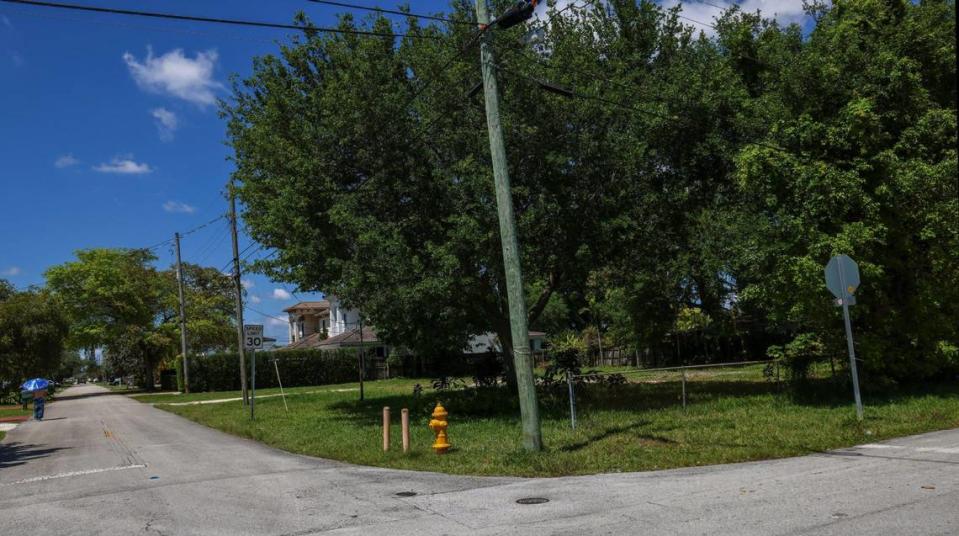The end of single-family-only home suburbs? Miami-Dade zoning rule impact could be ‘sweeping’
For the dozen years that Jose and Barbara Pazos have lived in Schenley Park, the century-old unincorporated neighborhood of single-family houses and ample trees that surrounds Nicklaus Children’s Hospital, they’ve seen their share of teardowns as modest old concrete bungalows get replaced with bigger, gleaming new homes.
The couple’s own house, built in 2011, occupies half of what had been a larger, leafy lot. That parcel was split in two by a developer who wedged in a pair of expansive new dwellings where once there was just one.
So the Pazos didn’t think much of it when their elderly next-door neighbor sold her 1951 house, on a spacious corner lot, to an investor who promptly flipped it, for $999,000, to a home developer.
But then a sales brochure from a real estate agency hit their mailbox, advertising four new luxury duplex homes — at $1.5 million each — to be built on the now-vacant neighboring lot.
What the surprised couple soon learned, after some determined digging: The planned duplexes, in an area long limited by zoning rules to detached single-family homes, are now allowed by a little-known Miami-Dade regulation designed to ease the county’s severe housing crunch.
The rule, a part of the county’s workforce housing program, gives owners of lots zoned for single-family homes in unincorporated areas like Schenley Park, which borders Coral Gables to the west, the right to build multiple housing units on their properties, with the number depending on the lot size.
Effectively, the rule appears to spell the end of exclusively single-family zoning — long a sacred cow in suburban Miami and the rest of the country — across unincorporated Miami-Dade. Some land-use experts say the potential impact in vast stretches of the county could be significant over time as low-density housing is gradually replaced with denser infill development. Jose Pazos believes that what’s happening next door to him will “spread like wildfire” through other neighborhoods, altering their look and feel for the worse.

To encourage its use, the rule requires no zoning variances, hearings or notifications to neighboring homeowners, just an administrative OK from the county zoning division.
To qualify for the zoning break, the developers must price the homes affordably for middle-income families -- defined as those making 60 percent to 120 percent of the county’s median household income, which stands at around $75,000 -- or pay a sum into the county’s affordable housing fund that varies according to project size. The new homes must also be designed to blend in with the surrounding neighborhood.
For the Pazos, the developer’s plan would mean four new homes next door in two separate structures, each two stories, where there was previously one small house, and driveways for eight cars just a few feet from their own.
They say that constitutes an unexpected, unwelcome transformation that could affect the quality of life for them and their two children, and alter the scale and character of a long-established neighborhood that people seek out for its peace, low density and dense greenery.
But they’ve had no chance to object, comment or even ask questions about the developer’s plan, which is under county review.
“This is a neighborhood of single-family homes that is over 100 years old,” a befuddled Jose Pazos said in an interview at the couple’s home. “I’ve never seen anything like this.”
Old rule getting rising new interest
The full impact of the rule, enacted relatively recently, is not yet clear. Approved by the Miami-Dade commission in 2016, the rule went into effect in 2018 but appears to have remained under the radar of developers until recently. According to figures from the county department of regulatory and economic resources, the number of applications under the rule has been rising steadily, from just one in 2018 to 53 in 2022 and 73 in 2023. So far this year, 17 applications have been submitted.
The potential for changing the face of Miami’s suburbs seems far-reaching, especially as home prices in South Florida hit historic highs and residential developers scour Miami-Dade for scarce available land to build on.
A whopping 87 percent of residential land area in Miami-Dade is dedicated to single-family housing, according to the county, although that includes 34 municipalities where the looser rule does not apply.
That still leaves broad swathes of single-family neighborhoods in unincorporated areas like Kendall, the Dadeland area or long stretches of West and North Miami-Dade, for instance, where property owners or developers can now replace detached homes with duplexes or townhouses, noted Ned Murray, associate director of the Metropolitan Center at Florida International University, who called the new rule a “sweeping change.” How many units can be placed on a lot depends on its size and a complicated formula that provides additional density allowances to build.
‘You really need to be transparent’
“I see on the zoning map there is a good chunk of land zoned in that classification. The ordinance was applied broadly so it would apply to these zones in total,” said Murray, whose institute has advocated for an expansion of affordable and workforce housing across the county. “It’s a significant change, and probably for good reason.”
Murray cautioned that while the rule’s goal of increasing housing supply by building more in low-density neighborhoods is laudable, planners and officials must be careful to ensure that residents understand the reasons for the change, and that new construction does not disrupt long-settled areas where families have invested.
“You have to applaud the county for being aggressive about affordable housing, but you still have to be careful,” Murray said. “You really need to be so transparent. There is always the issue of compatibility, and as a planner I’m always very sensitive about that, especially in single-family communities.”
Murray, who said he did not know of the change until a reporter sent him the ordinance language, said few others appear to be aware of it and questioned whether county officials have done enough to explain it publicly.
Steve Wernick, a veteran Miami zoning attorney, recalls debate over the measure in 2016, but said he’s not sure why it doesn’t appear to have been widely used so far. In the right hands, though, he said the rule could little by little help put a dent in housing scarcity.
“It’s voluntary, the changes are incremental and it’s not being forced on anyone,” Wernick said. “In the right hands, it should be useful. That will often depend on how a neighborhood functions. Does it have the infrastructure to handle this? Are the buildings well designed?”
County won’t discuss policy goals
County communications officials, while providing extensive factual background explanations of the rule, did not make anyone available for an interview on the rationale and goals of the policy. The communications director for the department of regulatory and economic resources suggested a reporter contact former Miami-Dade commissioner Barbara Jordan, who sponsored the measure as part of a series of amendments to the county workforce ordinance in 2016. Jordan retired from politics in 2020.
The agency issued a brief statement late Wednesday that said: “The goal of the ordinance adopted by the Board of Commissioners in 2007 establishing Chapter 33 of the County Code (Code) on workforce housing and subsequent adopted ordinances amending the Code was to increase workforce housing units by incentivizing developers to construct units throughout Miami-Dade.”
Neither the Miami developer looking to build next to the Pazos in Schenley Park, identified in the zoning application as Alex Gonzalez, or his attorney, Keith Diamond, of Hollywood, responded to several messages requesting an interview.

The measure is just one of a series of recent zoning changes at state, county and local level that are meant to significantly goose the supply of housing at all income levels by easing longstanding restrictions on height and density, especially for development of housing for low-income and middle-class families.
The changes are already leading to dramatic, sometimes jarring and often controversial changes in the urban and suburban landscape of Miami-Dade.
So far, those have been most evident around Metrorail and other transit stations and corridors such as the South Miami-Dade Busway where Miami-Dade has aggressively expanded special zones that have fostered dense and often high-rise construction. That has already led to conflict with the City of Miami, which has objected to the county’s pre-empting of local zoning restrictions, resulting in public negotiating sessions in hopes of coming up with a compromise.
Even more controversial has been the state’s year-old Live Local Act, which overrides local zoning rules in commercial and industrial districts to encourage developers to supersize projects that include certain set-asides for middle-class housing. After cities like Doral, Miami Beach and Bal Harbour batted back Live Local proposals last year, the legislature passed amendments this year that effectively supercharge the allowed scale and density of development while effectively blocking local governments or residents from seeking to stop or alter altering proposed projects in any way.
Though it has attracted far less attention, the change to single-family zoning in unincorporated Miami-Dade could be no less consequential over the long run.
A national trend
Though long seen as sacrosanct, the epitome of the American Dream, single-family-only zoning has come under increasing scrutiny and attack across the country. Some critics say the single-family zoning category, which makes it illegal to build multi-family housing on 75 percent of residential land in major American cities, is a principal cause of the nation’s affordability crisis.
Experts note that zoning restrictions, in particular those setting aside extensive neighborhoods for detached single-family homes, have been often used by local authorities to exclude lower-income families and racial and ethnic minorities. Single-family zoning, in fact, is historically rooted in deliberately exclusionary measures first approved a century ago in the early days of U.S. suburban expansion, experts say.
The states of California, Oregon, Washington, Montana and Maine have recently banned single-family-only zoning to encourage low-scale multi-family redevelopment in residential areas. Cities ranging from Gainesville in Florida to Minneapolis, Arlington and Charlotte, N.C., also have reformed single-family zoning laws in recent years.
In many places, the changes have generated angry pushback from critics who say they will destroy their neighborhoods. But the new rules so far have also not been widely embraced by developers and builders, possibly because high inflation and elevated interest rates have made it financially unattractive, at least for now.
Wernick, the Miami zoning attorney, said banks are often loath to lend to unfamiliar types of projects.
“Sometimes traditional residential lenders are slow to adjust to a new model. When you introduce something that’s creative or different, sometimes it takes them a while to catch on,” he said.
In Miami-Dade, where geography and a strict development boundary meant to protect the Everglades and the agricultural Redland limit the available land for housing construction, the measure could spur more efficient use of sprawling, low-density residential areas, FIU’s Murray said.
“Given the market the way it is and home prices as they are, this may present an investment opportunity for builders, small developers even existing homeowners,” Murray said. “At the same time, If we see more of this happening, it is going to create more anxiety for residents.”
‘Erasing our roots’
The Pazos say they fear the changes the measure will mean for them and their neighbors, which they predict won’t stop at the lot next door. Along with Live Local and spreading densification and redevelopment, they said, the county zoning change threatens to transform their native city into a place they no longer recognize and don’t feel welcome in.
“They are erasing our roots,” Jose Pazos said. “This is going to spread like wildfire. It’s a movement that is crashing into the suburbs, and this has made it real for a lot of people here in Schenley Park.”
For their neighbor Renier Viego, an unfair aspect of the developers’ duplex plan and the county change is that it springs a potentially significant alteration to the neighborhood with no real feedback from residents. Three years ago, Viego said, he moved to the adjoining single-family neighborhood of Coral Terrace, just a couple of blocks from the Pazos, from the Miami urban neighborhood of The Roads because dense residential redevelopment was changing its character too drastically.

“I understand high density and why people want to do it. But on the other hand, I want peace and quiet. This is why I moved to a neighborhood like this,” Viego said. “If it happens here it’s going to happen everywhere. I know everyone has their views about planning and big-city development, but you’re going to destroy neighborhoods.”
The Jordan measure grants developers an effective right to build multiple units in single-family neighborhoods and eases certain requirements like setbacks and lot-coverage limits.
To judge from the Schenley Park proposal, however, that doesn’t appear to mean a rubber stamp from regulators.
The county record shows zoning reviewers are closely scrutinizing the plan. They have kicked it back at least twice to the developers because they did not meet setback requirements, did not provide an adequate tree-preservation plan, and the designs as first submitted looked too much like duplexes, failing to sufficiently disguise the structures as single-family homes to blend into the neighborhood.
In a letter to the county, the developer, Gonzalez, has said he will pay an as-yet-unspecified amount into the county housing fund. Under county rules, that figure is calculated after construction and is based on the size of project.
The county’s online record indicates the plan remains under review and suggests communications with the developers are ongoing. It’s unclear what the developers’ response has been to the county critiques.
But one bit of evidence suggests a redesign may be under way: The web listing for the homes has been deleted.
This story has been update to include a statement from Miami-Dade County.

